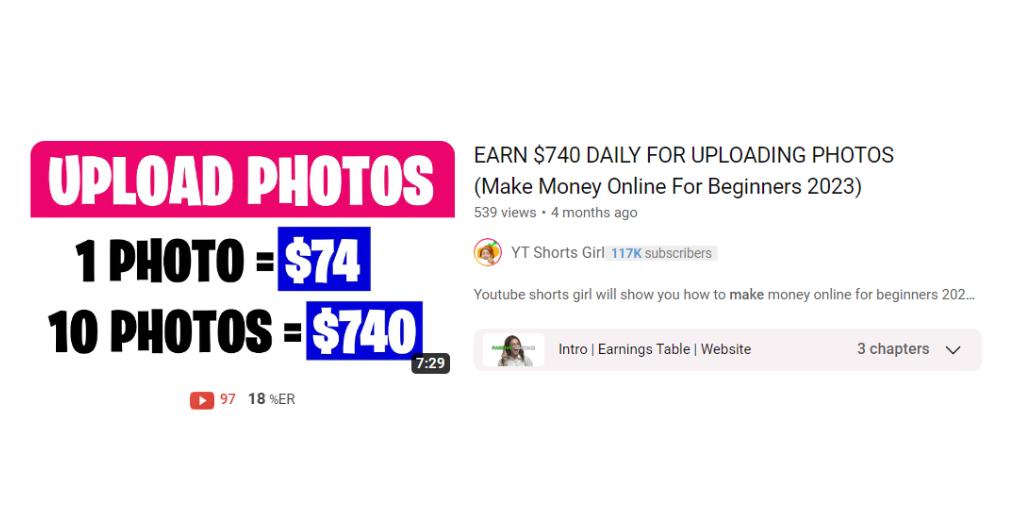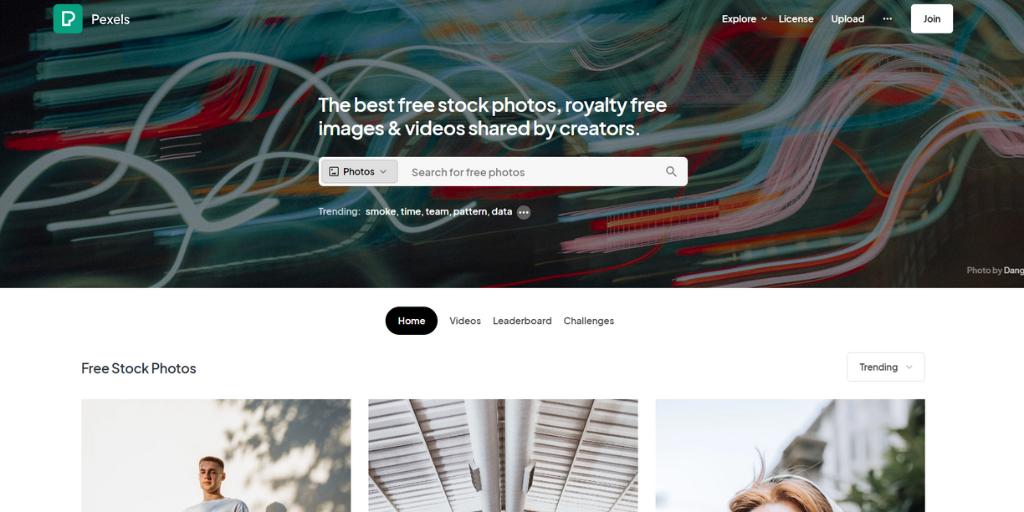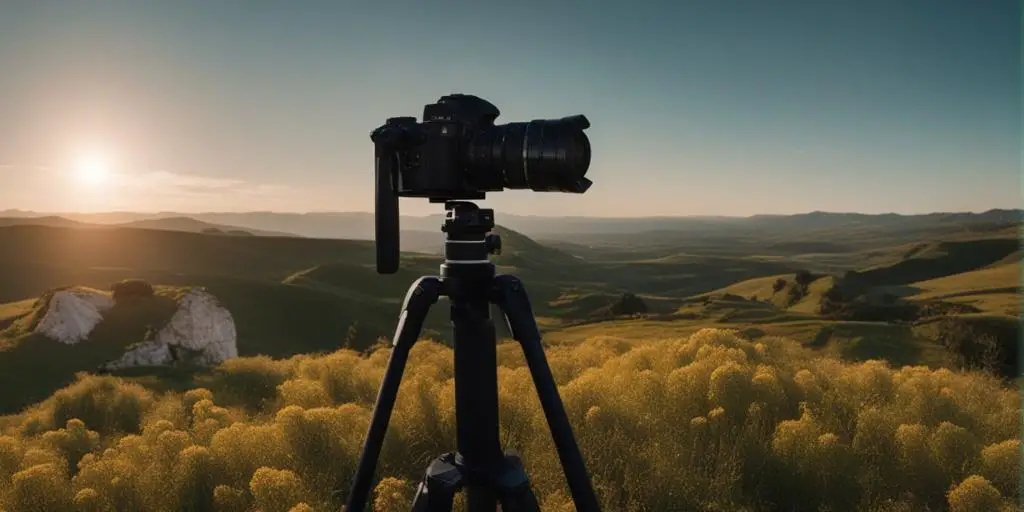As you know, YouTube is full of videos in the money-making niche that promise you a simple method to make hundreds of dollars every single day.
Unfortunately, most of these videos are misleading people and promising them unrealistic results.
I recently came across a video with a promising title –Earn $740 Daily by Uploading Photos.

In this video, the creator claims to offer an easy way to make money, so I thought I should share some important information with you.
As the title suggests, you can make hundreds of dollars every day by simply uploading photos to stock photo websites.
It sounds pretty easy, right?
But here’s the thing: this method is not only potentially illegal, but it can also have serious consequences for you.
So, let me explain why this approach can get you into trouble. And if you want, you can watch my video below which describes it even better.
Can You Earn $740 Daily by Uploading Photos?
The video demonstrates a method where you search for royalty-free images on platforms like Pexels or Unsplash, and then you upload and sell them on popular stock photo websites such as Shutterstock or Adobe Stock.

Now, on the surface, selling photos on stock photo websites seems like a great way to earn some extra cash, and I won’t deny that it can be.
Many photographers and designers are using this business model, and with some creativity, they can make good money.
However, there’s a key issue with the method shown in the video.
When you upload photos to stock photo websites, you are required to provide certain legal assurances and permissions.
This is a standard practice where you need to confirm that you have all the rights to upload and sell the photos.
In other words, these assurances typically include confirming that you own the rights to the images you upload or that you have obtained the necessary licenses to sell them.
And this is where the problem arises.
BONUS FOR YOU: There are AI tools that can help you make money and generate passive income – Get the list of money-making AI tools.
Emails suck, ours don’t. It’s usually under 300 words, and easy to read. It’s becoming the top newsletter for making extra money with your creative talents while keeping your regular job. More than 2,000 creative people have already joined. You should sign up too!
There Are Legal Issues With This Method
By taking someone else’s royalty-free images from websites like Pexels or Unsplash and selling them on stock photo platforms, you’re essentially misrepresenting the ownership of those images.
- What is worse, this is not only ethically wrong but can also be a violation of copyright laws.
Therefore, if the original copyright holder of the image discovers your actions, they can take legal action against you, potentially resulting in fines or other legal consequences.
Moreover, stock photo websites have strict policies in place to ensure the integrity of their platforms and protect the rights of photographers and image creators.
They are firmly opposed to this behavior. In other words, you cannot use any images or photographs from royalty-free websites and sell them on their platforms.
And if they discover that you are uploading and selling images without the proper ownership or licensing rights, they can ban you from their platform.
This means that not only will you lose any potential earnings, but you will also lose the opportunity to continue selling photos on these reputable websites.
Why Should You Sell AI Images?
So, you’re curious about some alternative options for making money through your creative skills?
Well, let me tell you about one interesting idea!
If you are a good and creative photographer or graphic designer, I highly recommend to try selling your work on popular websites like Shutterstock, Adobe Stock, Freepik, or 123RF. These platforms are super user-friendly and make the uploading process really simple.
Plus, they have a wide reach, which means more potential buyers for your creations!
But what if you aren’t a skilled photographer or designer?
Don’t worry, there is still something to share with you.
I bet you’ve already heard of AI-generated art. It’s a fascinating concept that’s gaining traction in the creative world and might be the perfect answer for you.
Here’s the scoop: AI image generators allow you to create illustrations or artwork in various styles, all in a relatively short amount of time.
And the best part? You can upload these AI-generated images to multiple stock photo platforms, increasing your chances of making sales.
Think of it as a numbers game, where the more photos you have in your portfolio, the greater your shot at success.
RELATED:
Pros and Cons of This Method

Of course, like any other method, there are pros and cons to consider.
One major advantage is the volume of artwork you can produce. You can create hundreds of images in a day, in various styles, easily showcasing your creativity.
Additionally, AI-generated art can often have a unique and futuristic aesthetic that appeals to certain buyers.
However, it’s important to note that the market for AI-generated art is still relatively new and evolving.
Some buyers may prefer traditional, human-created art and photography, while others are open to exploring the innovative possibilities of AI-generated artwork.
Finding the right audience for your work may require a bit of time.
Also, keep in mind that while AI-generated art can save you time in the creation process, it’s crucial to strike a balance between quantity and quality.
Buyers are still looking for captivating and visually appealing pieces, so you still need to focus on the quality of your images and illustrations.
Here Are a Few Challenges for Selling AI Images on Stock Photo Websites.
In this section of the article, I wanted to share some important information with you about selling AI-generated art on stock photo platforms.
All this information is based on my experience with creating and selling AI art.
First things first, you should understand, that not all platforms are open to accepting AI-generated art.
In my personal experience, I’ve found that platforms like Shutterstock, Getty Images, and Pond5 have restrictions in place. Unless you create the AI-generated art using their own AI image-generating tool (in the case of Shutterstock), they won’t accept it.
And it’s not just Shutterstock, there are other platforms that I have already mentioned, such as Pond5, Alamy, and Getty Images also have their own rules and limitations on AI content.
The good news is, that there are still platforms out there that allow you to upload your AI-generated art.
However, there are a few rules you need to follow. For example, you can’t label an AI-generated image as a photograph; instead, it should be described as an illustration.
Make sure to include in the description, title, or tags that the illustration was generated using AI. These platforms want transparency and clarity for their buyers.
And that is not all, there are still a few challenges you may encounter when selling AI-generated art.
The major concern is the saturation of the market. With the accessibility of AI image generators, more and more people are joining in, leading to increased competition.
Imagine how large someone’s portfolio would be in a few months if they uploaded 50 images a day.
Therefore, to be successful with AI art, you must stand out from the crowd. Unleash your creativity, and experiment with unique styles and techniques.
Another consideration is the quality of AI-generated art.
Although AI technology has made impressive advancements, there can still be instances where the generated images lack the finesse and uniqueness of manually created artwork.
To address this, it’s important to review any of your AI-generated pieces carefully. Ensure they meet the standards expected by customers in terms of composition, visual appeal, and overall quality.
Lastly, let’s discuss the review process.
And this is something that anyone who sells AI art would do.
Compared to standard photography, AI-generated images may take longer to get reviewed on certain platforms.
As an example, while regular photos can be reviewed within a few business days on platforms like Adobe Stock, the review process for AI-generated images may take a month or even longer.
So, keep this in mind. It’s important to be patient during this period, as it’s part of the process to ensure the quality and appropriateness of the art being uploaded.
Few Tips for Sellers of AI Art
If you’re still interested in selling AI-generated images on stock photo platforms, I’ve got some tips to share with you!
First and foremost, if you want to stand out from the crowd, you need to focus on creating images that real photographers would find difficult to capture.
What does that mean exactly?
Well, when customers are choosing between a real photograph and an AI-generated image, they tend to lean towards the real photograph.
To overcome this problem, create images that are challenging or even impossible for humans to create on their own.
Think about abstract concepts, futuristic or imaginative environments, or intriguing combinations of photos. This way, you’re not competing directly with real photos, but rather with other AI artists.
Another tip I can give you is to use services that will help you upload your images on multiple platforms.
You should consider using services like Wirestock.
Wirestock is an online stock site that allows you to upload your images and distribute them to multiple stock agencies. It’s a time-saver, but there are a few things to keep in mind.
While joining and using Wirestock is free, they’ve recently introduced a paid plan that they encourage users to opt for. This means that free users have a limit on the number of images they can submit per month.
Personally, I don’t find this to be a significant issue since I use Wirestock for platforms where I don’t have the time to upload directly.
It is important to keep in mind that Wirestock takes a commission from the images you sell through their platform.
They receive a 15% commission on the royalties earned from assets submitted through their channels. For any Wirestock “direct sales” made on their platform, they take a 30% commission. This could be a potential downside for many photographers and designers.
However, despite being aware of these limitations, I still find it beneficial to use Wirestock for submitting my artwork to stock photo platforms where I don’t submit directly.
Currently, I’m focusing on selling my AI-generated art directly on platforms like Adobe Stock and 123RF, while I let Wirestock handle submissions to other stock agencies.
Conclusion
I don’t know the future, but I plan on making an article to keep you updated on my side hustle journey and give you news about the progress soon.
So, stay tuned for that!
Selling AI-generated images can be a worthwhile side hustle to consider. If you don’t want to sell on stock photo platforms, you can try selling AI art on Fiverr or any other freelance website.
FAQs
If you have even more questions, here’s a FAQ section on selling AI-generated art on stock photo platforms:
Can I sell AI-generated art on all stock photo platforms?
The truth is, that not all platforms accept art generated by AI. Some platforms have restrictions in place, while others may require you to use their specific AI image-generating tools. It’s essential to understand the guidelines and requirements of each platform before submitting your AI-generated art.
How can I make my AI-generated art stand out from real photography?
To differentiate your AI-generated art from real photography, focus on creating images that are challenging or impossible for humans to capture. Explore abstract concepts, futuristic environments, or unique combinations of photos.
Are there any services that can help streamline the uploading process for AI-generated art?
Yes, services like Wirestock can assist in streamlining the uploading process. Wirestock allows you to upload your images once and distribute them to multiple stock agencies, saving you time and effort. However, be aware that Wirestock may have limitations for free users and takes a commission on the royalties earned from the images sold through their platform.
Are there any challenges specific to selling AI-generated art?
One challenge you will face is market saturation, as more people are utilizing AI image generators. That is why it is crucial to stand out from the competition. Another challenge is ensuring the quality of the AI-generated art itself. The AI image generators are not always perfect, so you need to review any generated images to ensure the best possible quality.
How long does it take for AI-generated images to get reviewed on stock photo platforms?
While standard photography can be reviewed within a few business days, AI-generated images may take longer, sometimes up to a month or more.
Which platforms are recommended for selling AI-generated art?
Platforms like Shutterstock, Adobe Stock, Freepik, and 123RF are popular platforms where you can sell AI-generated art.
However, Shutterstock only accepts AI images generated with their own AI image generators. Don’t forget that most platforms may have their own AI tools or require specific labeling and descriptions for AI-generated images.
BUSINESS TOOLS I USE
Throughout my journey of building multiple online businesses, I’ve had the opportunity to discover various products that can truly be time-saving and make the process of creating your own online business a bit smoother.
TOOLS FOR MAKING MONEY ONLINE
Beehiiv – One of the most lucrative ways to make money online is by having a newsletter. This is my favorite tool. You can start one for free on one of the best AI-powered newsletter platforms available. Star for free.
HighLevel – A platform that includes all the tools you need for starting an online business. Try the free trial.
- AI-powered newsletter platforms – ConvertKit (advanced), Beehiiv (beginners)
- AI image generator – Leonardo (beginners)
- AI text-to-video editor – Pictory
- Human-like AI Voices – WellSaid Labs (best), Murf (alternative)
- AI Writer – Jasper (best), Rytr (alternative)
- Sell Your Digital Products – Sellfy (paid), Payhip (free)
- Swiss Army Knife of AI tools – Notion
- Digital Marketing – Systeme
Disclosure: Some of the links above may contain affiliate partnerships, meaning, at no additional cost to you, Nechcloud may earn a commission if you click through to make a purchase.

